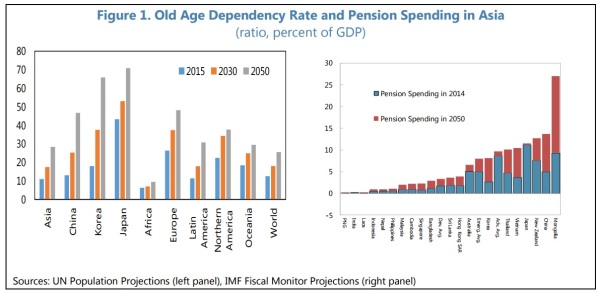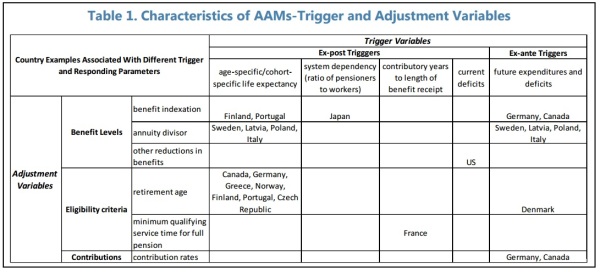I’ve looked at some of the grim fiscal implications of demographic changes the United States and Europe.
Now let’s look at what’s happening in Asia.
The International Monetary Fund has a recent study that looks at shortfalls in government-run pension schemes and various policies that could address the long-run imbalances in the region. Here are the main points from the abstract.
Asian economies are aging fast, with significant implications for their pension system finances. While some countries already have high dependency ratios (Japan), others are expected to experience a sharp increase in the next couple of decades (China, Korea, Singapore). …This has…implications. …pension system deficits can increase very quickly, limiting room for policy action and hampering fiscal sustainability. …This paper explores how incorporating Automatic Adjustment Mechanisms (AAMs)—rules ensuring that certain characteristics of a pension system respond to demographic, macroeconomic and financial developments, in a predetermined fashion and without the need for additional intervention— can be part of pension reforms in Asia.
More succinctly, AAMs are built-in rules that automatically make changes to government pension systems based on various criteria.
Incidentally, we already have AAMs in the United States. Annual Social Security cost of living adjustments (COLAs) and increases in the wage base cap are examples of automatic changes that occur on a regular basis. And such policies exist in many other nations.
But those are AAMs that generally are designed to give more money to beneficiaries. The IMF study is talking about AAMs that are designed to deal with looming shortfalls caused by demographic changes. In other words, AAMs that result in seniors getting lower-than-promised benefits in the future. Here’s how the IMF study describes this development.
More recently, AAMs have come to the forefront to help address financial sustainability concerns of public pension systems. Social insurance pension systems are dominated by defined benefit schemes, pay-as-you-go financed, with liabilities explicitly underwritten by the government. …these systems, under their previous contribution and benefit rules, are unprepared for population aging and need to implement parametric reform or structural reforms in order to reduce the level or growth rate of their unfunded pension liabilities. …Automatic adjustments can theoretically make the reform process politically less painful and more likely to succeed.
Here’s a chart from the study that underscores the need for some sort of reform. It shows the age-dependency ratio on the left and the projected increase in the burden of pension spending on the right.

I’m surprised that the future burden of pension spending in Japan will only be slightly higher than it is today.
And I’m shocked by the awful long-run outlook in Mongolia (the bad numbers for China are New Zealand are also noteworthy, though not as surprising).
To address these grim numbers, the study considers various AAMs that might make government systems fiscally sustainable.
Especially automatic increases in the retirement age based on life expectancy.
One attractive option is to link statutory retirement ages—which seem relatively low in the region—to longevity or other sustainability indicators. This would at the very least help ameliorate the impact of life expectancy improvements in the finances of public pension systems. … While some countries have already raised the retirement age over time (Japan, Korea), pension systems in Asia do not yet feature automatic links between retirement age and life expectancy. …The case studies for Korea and China (section IV) suggest that automatic indexation of retirement age to life expectancy can indeed help reduce the pension system’s financial imbalances.
Here’s a table showing the AAMs that already exist.

Notice that the United States is on this list with an “ex-post trigger” based on “current deficits.”
This is because when the make-believe Trust Fund runs out of IOUs in the 2030s, there’s an automatic reduction in benefits. For what it’s worth, I fully expect future politicians to simply pass a law stating that promised benefits get paid regardless.
It’s also worth noting that Germany and Canada have “ex-ante triggers” for “contribution rates.” I’m assuming that means automatic tax hikes, which is a horrid idea. Heck, even the study acknowledges a problem with that approach.
…raising contribution rates can have important effects on the labor market and growth, it would be important to prioritize other adjustments.
From my perspective, the main – albeit unintended – lesson from the IMF study is that private retirement accounts are the best approach. These defined contribution (DC) systems avoid all the problems associated with pay-as-you-go, tax-and-transfer regimes, generally known as defined benefit (DB) systems.
The larger role played by defined contribution schemes in Asia reduce the scope for using AAMs for financial sustainability purposes. Many Asian economies (Hong Kong, Singapore, Australia, Malaysia and Indonesia) have defined contribution systems, …under which system sustainability is typically inherent.
Here are the types of pension systems in Asia, with Australia and New Zealand added to the mix.
For what it’s worth, I would put Australia in the “defined contribution” grouping. Yes, there is still a government age pension that serves as a safety net, but there also are safety nets in Singapore and Hong Kong as well.
But I’m nitpicking.
Here’s another table from the study showing that it’s much simpler to deal with “DC” systems compared with “DB” systems. About the only reforms that are ever needed revolve around the question of how much private savings should be required.
By the way, even though the information in the IMF study shows the superiority of DC plans, that’s only an implicit message.
To the extent the bureaucracy has an explicit message, it’s mostly about indexing the retirement age to changes in life expectancy.
That’s probably better than doing nothing, but there’s an unaddressed problem with that approach. It forces people to spend more years working and paying into systems, and then leaves them fewer years to collect benefits in retirement.
That idea periodically gets floated in the United States. Here’s some of what I wrotein 2011.
Think of this as the pay-for-a-steak-and-get-a-hamburger plan. Social Security already is a bad deal for workers, forcing them to pay a lot of money in exchange for relatively meager retirement benefits.
I made a related observation about this approach back in 2012.
…it focuses on the government’s finances and overlooks the implications for households. It is possible, at least on paper, to “save” Social Security by cutting benefits and raising taxes. But such “reforms” force people to pay more and get less – even though Social Security already is a very bad deal, particularly for younger workers.
The bottom line is that the implicit message should be explicit. Other nations should copy jurisdictions such as Chile, Australia, and Hong Kong by shifting to personal retirement accounts
P.S. Speaking of which, here’s the case for U.S. reform, as captured by cartoons. And you can enjoy other Social Security cartoons here, here, and here, along with a Social Security joke if you appreciate grim humor.
———
Image credit: Pedro Ribeiro Simões | CC BY 2.0.



